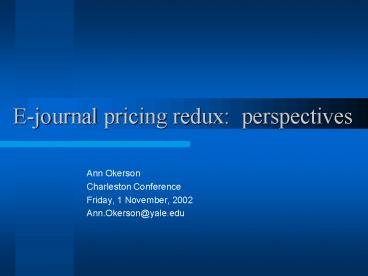Ejournal pricing redux: perspectives - PowerPoint PPT Presentation
1 / 10
Title:
Ejournal pricing redux: perspectives
Description:
E-journal pricing redux: perspectives. Ann Okerson. Charleston Conference ... Ann.Okerson_at_yale.edu. Pricing for the day after tomorrow. We are all looking for ... – PowerPoint PPT presentation
Number of Views:35
Avg rating:3.0/5.0
Title: Ejournal pricing redux: perspectives
1
E-journal pricing redux perspectives
- Ann Okerson
- Charleston Conference
- Friday, 1 November, 2002
- Ann.Okerson_at_yale.edu
2
Pricing for the day after tomorrow
- We are all looking for better models
- Fairer ones
- More affordable ones
- Much of e-resource pricing already tries to be a
surrogate for use - Carnegie, budget, FTE, sites, etc.
- A feeble or blunt surrogate for now
- But better days are coming, right?
3
Pricing for the day after tomorrow (2)
- Will describe two models recently discussed in
our consortium - Applicable to publish packages
- The sliding scale model
- The pay for what you use model
- Both are more nuanced versions of current
practice - None got very far why is that?
4
Sliding Scale model (1)
- Applied when the basis of pricing is the print
subscription and e- is the add-on - And publisher offers customers free e-access to
titles taken in print paid access to the rest - Whats a fair way to charge for the rest?
- Extreme 1 library doesnt take many print
titles low motivation for the rest - Extreme 2 library takes most of the print
titles low motivation for the rest
5
Sliding Scale model (2)
- Ergo, the middle range subscribers would pay
the most for the rest - Refinements are needed, for example
- Library chooses to cancel print and go e-only
- Cost becomes 80 of print price unsubbed price
remains as per sliding scale - Library chooses to cancel a title altogether
- Title moves from subbed and changes position on
sliding scale
6
(No Transcript)
7
Pay for What You Use model (1)
- This model works for e-only as well
- It depends on usage data
- The usage data are put into a spreadsheet and
graphed - Customer identifies the low use point on the
graph, where - Loss impedes customer service
- Document delivery is affordable
- Or other factors
8
Pay for What You Use model (2)
- So, low use could be, e.g.,
- Uses below 50 per year
- Uses that average at a certain defined percentage
of average use - Or, one could define high use
- A cap would need to be placed on the high use
so that predictable budgeting is possible
9
(No Transcript)
10
Miles to go
- Why didnt these work?
- They are not universally applicable
- They are not (as) easy to understand
- They need a lot of work (god is in the details)
- Libraries didnt like (usage data are so
unsophisticated, price for use controversial) - Publisher didnt like the idea (access loss,
revenue loss) - Maybe the models are just plain wrong
- Is it too soon? Yes and no!































